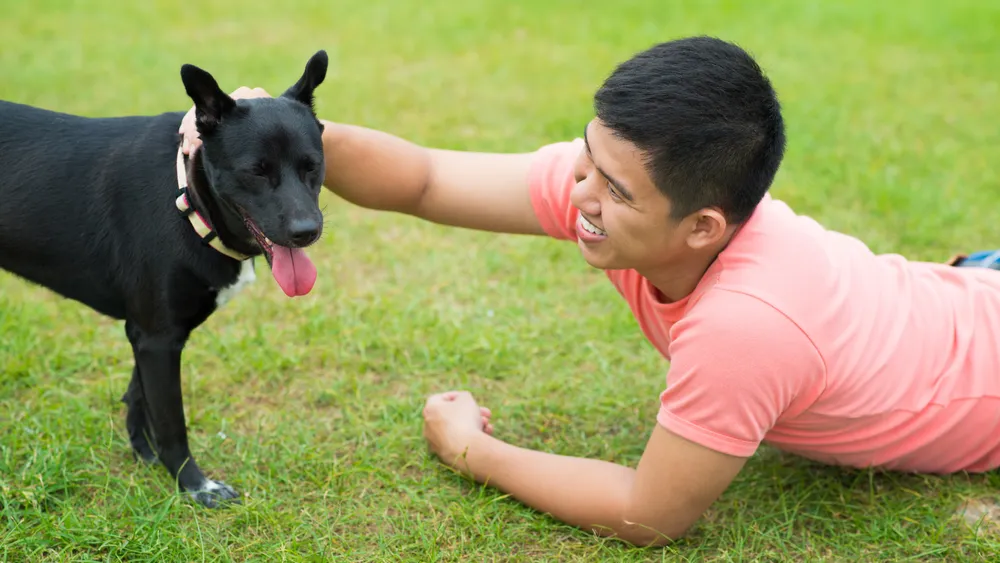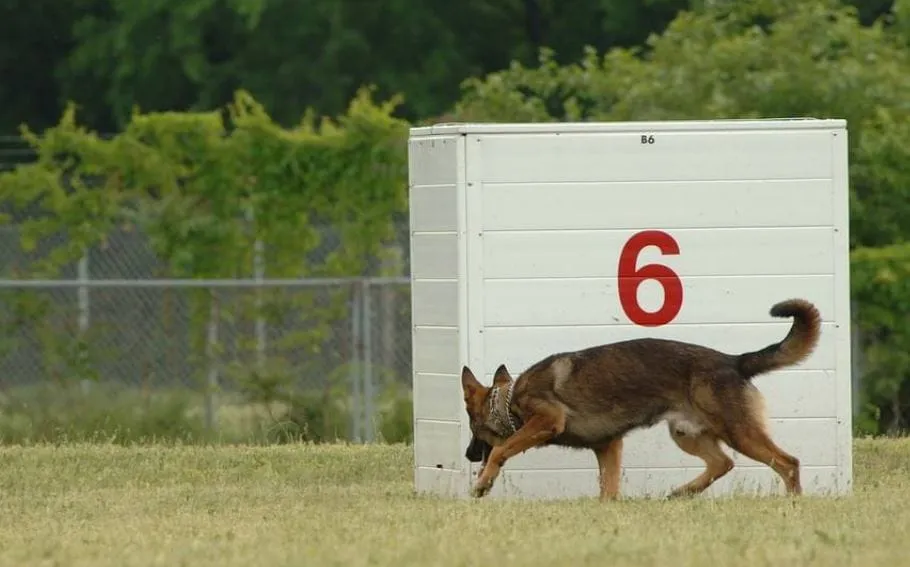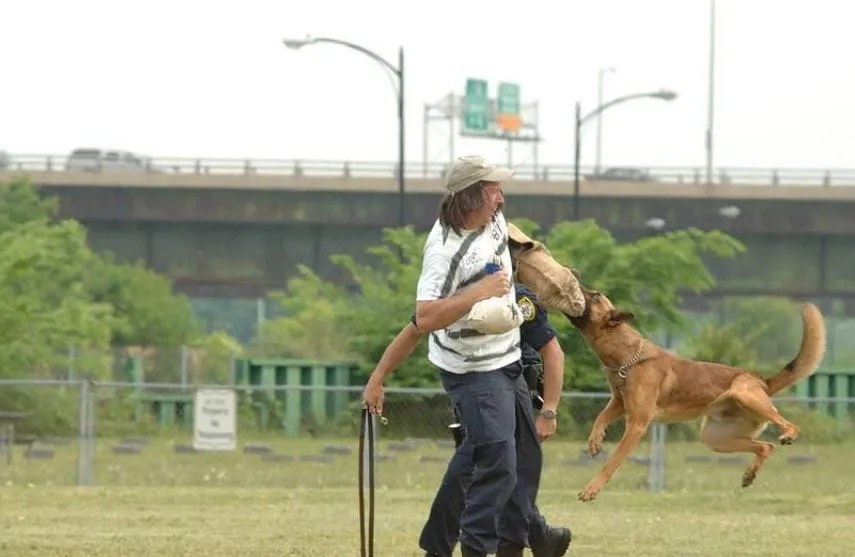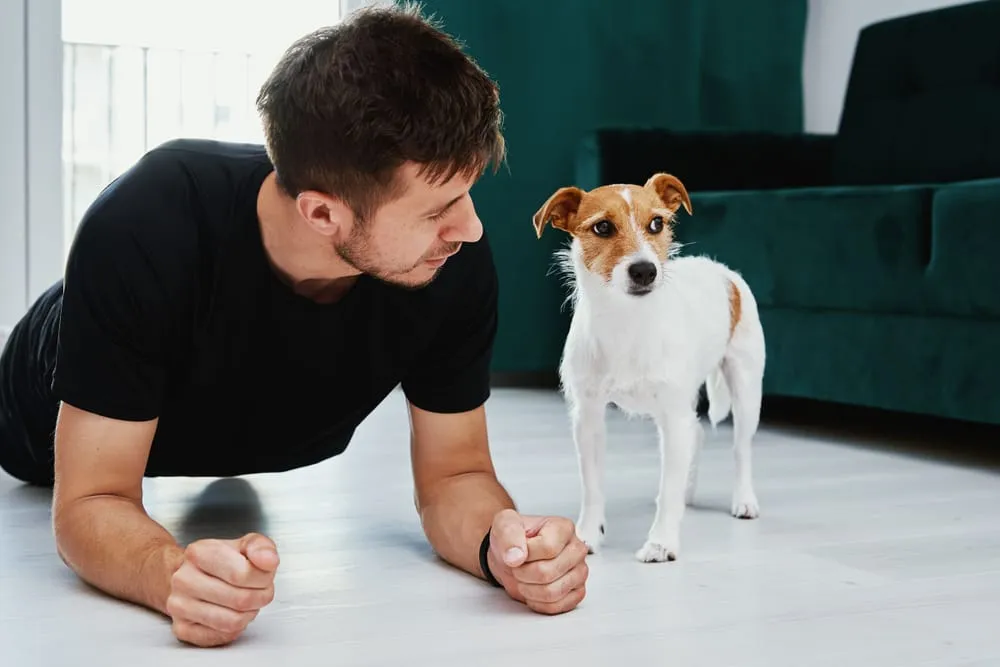Dog confidence-building exercises are a crucial aspect of pet ownership, as they help dogs develop a positive self-image and become more self-assured. Confidence-building activities are particularly important for dogs that have experienced trauma or have a naturally timid disposition. These exercises can help your furry friend develop the confidence they need to overcome their fears and live a happy, healthy life.

There are many different types of dog confidence building exercises that can be used to help your pet build self-esteem. One popular exercise is the "touch" game, where the dog is encouraged to touch different objects with their nose or paw. This game helps dogs develop confidence in their ability to explore new things and overcome their fear of the unknown. Another effective exercise is the " find it" game, where the dog is encouraged to search for hidden treats or toys. This game helps dogs develop problem-solving skills and boosts their confidence as they successfully complete the task.
Understanding Dog Confidence
Dogs, like humans, can experience a range of emotions, including fear and nervousness. A confident dog is one that is well-adjusted, comfortable in its environment, and able to handle new situations with ease. Understanding the signs of a fearful dog and the impact of nervousness on behavior is essential for building a dog's confidence.
Signs of a Fearful Dog
A fearful dog may exhibit a range of behaviors, including trembling, hiding, excessive barking, and aggression. It is important to recognize these signs and address them appropriately. A dog that is fearful or shy may not be well-socialized, and may need additional training and socialization to build confidence.
The Impact of Nervousness on Behavior
Nervousness can have a significant impact on a dog's behavior. A nervous dog may be more likely to bark excessively, become aggressive, or exhibit other unwanted behaviors. It is important to address nervousness in dogs to prevent these behaviors from becoming a problem.

Role of Socialization in Confidence Building
Socialization is an essential aspect of building a dog's confidence. A well-socialized dog is one that has been exposed to a variety of people, animals, and environments, and is comfortable in new situations. Socialization can help reduce a dog's nervousness and fearfulness, and build confidence.
Understanding the signs of a fearful dog, the impact of nervousness on behavior, and the role of socialization in confidence building is essential for any dog owner. By recognizing and addressing these issues, owners can help their dogs become confident, well-adjusted, and happy pets.
Foundations of Confidence-Building
Positive Reinforcement Explained
Positive reinforcement is a training technique that rewards a dog for good behavior. This method is based on the idea that dogs are more likely to repeat behaviors that are followed by a positive consequence. Positive reinforcement can be used to build a dog's confidence by rewarding them for exhibiting confident behavior.
For example, if a dog is nervous around strangers, their owner can use positive reinforcement to build their confidence. The owner can reward the dog for approaching a stranger or for staying calm in their presence. Over time, the dog will learn that approaching strangers or being around them is a positive experience.
The Basics of Puppy Socialization
Puppy socialization is the process of exposing a puppy to different people, animals, and environments in a positive way. This process helps the puppy develop confidence and social skills that will last a lifetime.
Puppy socialization should begin as early as possible, ideally between 3 and 14 weeks of age. During this time, the puppy should be exposed to a variety of people, including men, women, children, and people of different races. They should also be exposed to other animals, such as cats, dogs, and livestock.
Basic obedience skills should also be introduced during this time, such as sit, stay, and come. These skills will help the puppy feel more confident and in control of their environment.

Positive reinforcement and puppy socialization are important foundations for building a dog's confidence. By using these techniques, owners can help their dogs become more confident and well-adjusted members of society.
Confidence-Building Techniques
Dogs, like humans, can lack confidence in certain situations. However, building their confidence can help them become more well-adjusted and happier pets. Here are some techniques that can help:
Desensitization and Counter-Conditioning
Desensitization involves gradually exposing the dog to a stimulus they fear or are uncomfortable with, such as loud noises or unfamiliar people. Counter-conditioning involves changing the dog's emotional response to the stimulus by pairing it with something positive, such as treats or praise.
For example, if a dog is afraid of thunder, desensitization would involve playing a recording of thunder at a low volume and gradually increasing the volume over time. Counter-conditioning would involve giving the dog treats or praise while the thunder recording is playing, so they associate the sound with positive experiences.
Targeting and Trick Training
Targeting involves teaching the dog to touch a specific object with their nose or paw, such as a target stick or a hand. Trick training involves teaching the dog to perform specific behaviors on command, such as rolling over or giving a high-five.
Both of these techniques can help build a dog's confidence by giving them a sense of accomplishment and improving their focus and obedience.
Interactive Games and Mental Stimulation
Interactive games, such as hide-and-seek or fetch, can help build a dog's confidence by encouraging them to explore and interact with their environment. Mental stimulation, such as puzzle toys or scent work, can also help build confidence by giving the dog a sense of control and accomplishment.
These techniques can also help prevent boredom and destructive behavior, as well as improve the dog's overall well-being.
Overall, building a dog's confidence takes time and patience, but it can have a significant impact on their behavior and quality of life. By using these techniques and providing a positive and supportive environment, owners can help their dogs become more confident and happy pets.

Advanced Exercises for Confidence
Free Shaping Games
Free shaping games are a great way to build confidence in dogs. In these games, the dog is allowed to explore and interact with objects freely, without any pressure or guidance from the owner. This helps the dog build confidence and problem-solving skills.
One example of a free shaping game is ""find the toy."" In this game, the owner hides a toy in a room and allows the dog to search for it. The owner can gradually increase the difficulty of the game by hiding the toy in more challenging locations.
Another example is ""the cup game."" In this game, the owner places a treat under one of three cups and allows the dog to choose which cup to investigate. The owner can gradually increase the difficulty of the game by adding more cups or changing the location of the treat.
101 Things to Do with a Box
Using a box to play games with a dog is a great way to build confidence and problem-solving skills. One example is ""the treat box game."" In this game, the owner places a treat in a box and allows the dog to figure out how to get it out. The owner can gradually increase the difficulty of the game by adding obstacles or hiding the treat in more challenging locations.
Another example is ""the obstacle course game."" In this game, the owner sets up an obstacle course using boxes and allows the dog to navigate it. The owner can gradually increase the difficulty of the game by adding more obstacles or changing the layout of the course.
Find the Treats
""Find the treats"" is a great game for building confidence and problem-solving skills in dogs. In this game, the owner hides treats around the house and allows the dog to search for them. The owner can gradually increase the difficulty of the game by hiding the treats in more challenging locations or adding obstacles.
Another example is ""the scent game."" In this game, the owner places a treat in a container and allows the dog to use their sense of smell to find it. The owner can gradually increase the difficulty of the game by using more challenging scents or hiding the container in more challenging locations.
Overall, these advanced exercises for confidence are a great way to build a dog's problem-solving skills and confidence. By gradually increasing the difficulty of the games, owners can help their dogs become more confident and independent.

Dealing with Specific Fears
Overcoming Fear of Strangers
Many dogs, especially shy and fearful ones, can be intimidated by new people. To build confidence in these dogs, it's important to expose them to new people in a controlled and positive way. One effective exercise is to have the dog sit or lie down while a stranger approaches slowly and calmly. The dog should be rewarded with treats and praise for remaining calm and relaxed. Over time, the stranger can get closer and even offer a treat to the dog, further reinforcing positive associations.
It's also important to teach the dog basic obedience commands, such as "sit" and "stay," so that they feel more in control of the situation. This can help to build confidence and reduce anxiety around strangers.
Handling Discomfort with New Stimuli
Dogs can also be fearful of new stimuli, such as loud noises or unfamiliar objects. To help them overcome these fears, it's important to gradually expose them to the stimulus in a controlled and positive way. For example, if a dog is afraid of a vacuum cleaner, the owner can start by simply placing the vacuum cleaner in the room and rewarding the dog for remaining calm. Over time, the vacuum cleaner can be turned on for short periods of time, with the dog being rewarded for remaining calm and relaxed.
It's also important to avoid forcing the dog to confront their fears, as this can make the problem worse. Instead, the dog should be allowed to approach the stimulus at their own pace, with plenty of positive reinforcement along the way.
By using these confidence building exercises, owners can help their dogs to overcome specific fears and become more confident and well-adjusted pets.
When to Seek Professional Help
While many dog owners can successfully build their dog's confidence through various exercises, there are instances where seeking professional help is necessary. A veterinary behaviorist is an expert in animal behavior and can provide invaluable assistance in cases where a dog's confidence issues are more severe.
Role of a Veterinary Behaviorist
A veterinary behaviorist is a licensed veterinarian who has undergone specialized training in the field of animal behavior. They can diagnose and treat a wide range of behavior issues, including those related to confidence. They can work with dogs of all ages and breeds, and their treatment plans are tailored to each individual dog's needs.
If a dog's confidence issues are severe, such as extreme fear or aggression, a veterinary behaviorist may be necessary. They can provide a thorough assessment of the dog's behavior and develop a treatment plan that may include medication, behavior modification exercises, and training techniques.
In addition to providing treatment for the dog, a veterinary behaviorist can also work with the owner to ensure that they are equipped with the knowledge and skills necessary to continue the treatment plan at home. They can provide guidance on how to properly implement behavior modification exercises and offer support throughout the process.
Overall, seeking the help of a veterinary behaviorist can greatly improve a dog's confidence and overall behavior. It's important to remember that there is no shame in seeking professional help and that doing so can ultimately lead to a happier and healthier dog.

Exercise and Play for Confidence
Playing with your dog is not only a fun activity, but it can also help build their confidence. Here are a few exercises you can try with your furry friend to help boost their self-assurance.
Tug of War and Fetch
Tug of war and fetch are two classic games that many dogs love to play. These games can help build your dog's confidence by allowing them to use their natural instincts and tap into their prey drive. When playing tug of war, make sure to use a sturdy rope toy and let your dog win sometimes. This will help them feel more confident and in control. When playing fetch, start with short distances and gradually increase the distance as your dog becomes more comfortable.
The Importance of Timing in Play
Timing is crucial when playing with your dog. If you wait too long to correct bad behavior or reward good behavior, your dog may not understand what they did wrong or right. Similarly, if you interrupt your dog's playtime too often, they may become frustrated and lose confidence. It's important to find the right balance and make sure your timing is consistent.
Overall, playing with your dog can be a great way to build their confidence and strengthen your bond. Make sure to incorporate these exercises into your playtime routine and watch your dog's confidence soar.

Training Techniques for Confidence
Clicker Training Basics
Clicker training is a popular method for building confidence in dogs. It involves using a clicker to mark desired behaviors and then rewarding the dog with a treat. The clicker is a small device that makes a distinct clicking sound when pressed. This sound is used to signal to the dog that they have performed the desired behavior and will receive a reward.
To use clicker training for confidence building, start by teaching the dog simple behaviors such as sitting or lying down. Click and treat the dog every time they perform the desired behavior. Gradually increase the difficulty of the behavior and continue to click and treat the dog when they perform it correctly.
Clicker training can be especially effective for building confidence in shy or fearful dogs. By breaking down behaviors into small, manageable steps, the dog can gradually build their confidence and learn to trust their handler.
Treat and Retreat Method
The treat and retreat method is another effective way to build confidence in dogs. This method involves using treats to encourage the dog to explore new environments or objects. The handler should start by placing a treat near the object or in the new environment and allowing the dog to approach and eat the treat.
As the dog becomes more comfortable, the handler can gradually move the treat further away from the object or into the new environment. The dog will learn that exploring new things is rewarding and will become more confident over time.
It's important to note that the treat and retreat method should be used in conjunction with positive reinforcement training. The dog should never be forced to approach something they are afraid of, as this can make their fear worse.
Overall, both clicker training and the treat and retreat method can be effective tools for building confidence in dogs. By using positive reinforcement and breaking down behaviors into manageable steps, handlers can help their dogs become more confident and well-adjusted.

Avoiding Overwhelm
When it comes to building confidence in dogs, it's important to avoid overwhelming them. Overwhelm can occur when a dog is faced with a situation or task that is too challenging for their current level of confidence. This can lead to fear, anxiety, and even aggression.
Understanding and Avoiding Flooding
Flooding is a common cause of overwhelm in dogs. This occurs when a dog is exposed to a stimulus that is too intense or too prolonged. For example, if a dog is afraid of thunderstorms, locking them in a room during a storm could be considered flooding.
To avoid flooding, it's important to gradually expose your dog to new situations and stimuli. This can be done through desensitization and counterconditioning techniques. These techniques involve gradually introducing your dog to the stimulus in a controlled and positive way, while rewarding them for calm behavior.
It's also important to pay attention to your dog's body language and behavior. Signs of overwhelm include panting, drooling, pacing, and avoidance behavior. If you notice these signs, it's important to back off and give your dog a break.
By understanding and avoiding flooding, you can help your dog build confidence in a safe and positive way.
Conclusion
In conclusion, confidence-building exercises play a vital role in nurturing a well-adjusted, happy, and secure dog. Whether it's through interactive games like "touch" and "find it," or more advanced techniques like desensitization, counter-conditioning, and free shaping games, each activity is designed to challenge and encourage your dog in a supportive way. Positive reinforcement and proper socialization from a young age set a strong foundation, while targeted training techniques can address specific fears and build trust.
It's crucial to proceed with patience, recognizing your dog's limits to avoid overwhelm, and to celebrate their successes, no matter how small. For those challenging cases where progress seems slow or stagnant, seeking the guidance of a professional, such as a veterinary behaviorist, can provide tailored strategies and reassurance. Ultimately, by investing time and effort into confidence-building exercises, dog owners can foster a deep bond with their pets, leading to a more fulfilling relationship for both.

FAQs
- What are dog confidence-building exercises?
- Dog confidence-building exercises are activities designed to help dogs become more self-assured and less fearful. These exercises can range from simple games like "touch" and "find it" to more complex training techniques such as desensitization and counter-conditioning.
- Why are confidence-building exercises important for dogs?
- These exercises are crucial for dogs, especially those who are naturally timid or have experienced trauma, as they help improve self-esteem, reduce anxiety, and enable dogs to handle new situations more comfortably.
- Can confidence-building exercises help with my dog's fear of strangers?
- Yes, specific exercises like controlled exposure to new people, combined with positive reinforcement, can significantly reduce a dog's fear of strangers and build confidence in social situations.
- What role does socialization play in a dog's confidence?
- Socialization is vital for building confidence in dogs. It involves exposing them to a variety of people, animals, and environments in a positive manner, reducing nervousness and fearfulness in new situations.
- How can I use positive reinforcement to build my dog's confidence?
- Positive reinforcement involves rewarding your dog for confident behavior or calm responses in potentially stressful situations. Treats, praise, and toys can be used as rewards to reinforce desired behaviors.
- What are some advanced confidence-building exercises for dogs?
- Advanced exercises include free shaping games, "find the treat" activities, and creating obstacle courses that encourage problem-solving and independent thinking, further boosting a dog's confidence.
- When should I consider seeking professional help for my dog's confidence issues?
- If your dog's confidence issues are severe, causing extreme fear, anxiety, or aggression, consulting a veterinary behaviorist or a professional dog trainer can provide specialized strategies for improvement.
- How can playtime activities like tug of war and fetch help build confidence?
- Playtime activities like tug of war and fetch tap into a dog's natural instincts, provide mental and physical stimulation, and can enhance their sense of control and achievement, contributing to overall confidence.
- What is clicker training, and how can it be used for confidence building?
- Clicker training is a method that uses a click sound to mark desired behaviors, followed by a reward. It's effective for building confidence as it breaks down behaviors into small, achievable steps, allowing for positive reinforcement.
- How can I prevent overwhelming my dog during confidence-building exercises?
- It's important to gradually introduce new stimuli and challenges, paying close attention to your dog's body language and stress signals, and adjusting the difficulty of exercises to avoid causing fear or anxiety.




